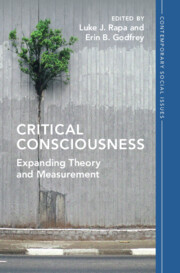Book contents
- Critical Consciousness
- Contemporary Social Issues
- Critical Consciousness
- Copyright page
- Dedication
- Contents
- Figures
- Tables
- Contributors
- Acknowledgments
- Introduction Critical Consciousness Theory and Measurement
- Part I Theory
- 1 Synthesizing Critical Consciousness and Identity-Based Motivation to Clarify How Youth of Color Navigate and Challenge Racial Capitalism
- 2 Situating Critical Consciousness Within the Developmental System
- 3 Integrating Critical Consciousness and Social Empathy
- 4 Critical Consciousness in Early to Middle Childhood
- 5 Adolescents’ Developmental Pathways to Critical Consciousness in the Contexts of Racial Oppression and Privilege
- 6 Making Reflection Critical
- Part II Measurement
- Conclusion Expanding Critical Consciousness Theory and Measurement
- Index
- References
2 - Situating Critical Consciousness Within the Developmental System
Insights from the Phenomenological Variant of Ecological Systems Theory
from Part I - Theory
Published online by Cambridge University Press: 20 April 2023
- Critical Consciousness
- Contemporary Social Issues
- Critical Consciousness
- Copyright page
- Dedication
- Contents
- Figures
- Tables
- Contributors
- Acknowledgments
- Introduction Critical Consciousness Theory and Measurement
- Part I Theory
- 1 Synthesizing Critical Consciousness and Identity-Based Motivation to Clarify How Youth of Color Navigate and Challenge Racial Capitalism
- 2 Situating Critical Consciousness Within the Developmental System
- 3 Integrating Critical Consciousness and Social Empathy
- 4 Critical Consciousness in Early to Middle Childhood
- 5 Adolescents’ Developmental Pathways to Critical Consciousness in the Contexts of Racial Oppression and Privilege
- 6 Making Reflection Critical
- Part II Measurement
- Conclusion Expanding Critical Consciousness Theory and Measurement
- Index
- References
Summary
Over a relatively short period of time, critical consciousness (CC) has become a prominent framework for describing how the developing person addresses systems of oppression. However, there has been less work to situate CC within developmental systems theory. The phenomenological variant of ecological systems theory (PVEST) is a developmental systems theory that accounts for how the reality of oppression influences developmental contexts and processes. We draw on PVEST to illuminate new theoretical directions for CC, including: (1) considering the broader context of CC within the developmental system; (2) addressing meaning-making as a primary developmental process that impacts CC; (3) considering CC as embedded in time, and (4) focusing on the dynamic and collective nature of CC. We explore the combined strengths of CC and PVEST to imagine new research questions that explore the contextualized and dynamic ways young people contend with systems of oppression across development.
Keywords
- Type
- Chapter
- Information
- Critical ConsciousnessExpanding Theory and Measurement, pp. 41 - 62Publisher: Cambridge University PressPrint publication year: 2023
References
- 3
- Cited by

